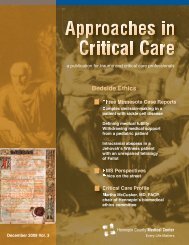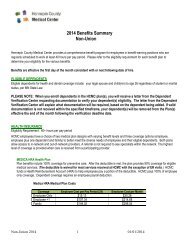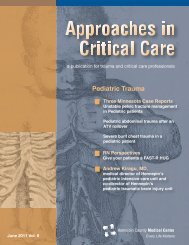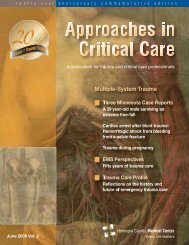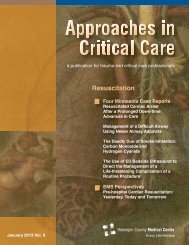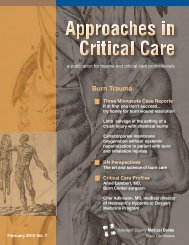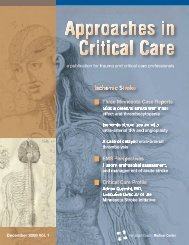Em. Med. Annual Report 2011 - Hennepin County Medical Center
Em. Med. Annual Report 2011 - Hennepin County Medical Center
Em. Med. Annual Report 2011 - Hennepin County Medical Center
You also want an ePaper? Increase the reach of your titles
YUMPU automatically turns print PDFs into web optimized ePapers that Google loves.
Rapid Anti-seizure<br />
<strong>Med</strong>ication Prior to Arrival<br />
Trial (RAMPART). Jeff Ho,<br />
an EM staff physician,<br />
has monitored TASER<br />
use by law enforcement<br />
in our area and offers<br />
scientifically sound<br />
Robert Long, MD<br />
recommendations for its<br />
(1938-2005)<br />
use. Drs. Ho, Hick and<br />
Mahoney provide field supervision of HCMC<br />
ambulance paramedics.<br />
HCMC, including the ED, is on the cutting edge of<br />
the digital documentation revolution. This has<br />
been possible in the ED because both nursing and<br />
physician staff have been led by leaders with<br />
computing skills. Marsha Zimmerman, RN, and<br />
Joseph Clinton, MD have patiently overcome the<br />
difficulties associated with this huge challenge.<br />
Other departments, especially <strong>Med</strong>ical Imaging,<br />
have also contributed.<br />
The Crisis Intervention <strong>Center</strong> (CIC), now called<br />
Acute Psychiatric Services (APS), had its<br />
beginning in Minneapolis General Hospital in the<br />
60's when a telephone on the ER nurse's desk<br />
was dedicated to "suicide calls." In 1967 Zigfrids<br />
Stelmachers (1928-2006), a Ph.D. Psychologist in<br />
the Psychiatry Department, arranged for Mental<br />
Health <strong>Center</strong> staff to relieve ER nursing staff of<br />
this responsibility. In 1968 a small area adjacent to<br />
the ER was added to allow face-to-face interviews<br />
between mentally unstable or depressed patients<br />
presenting to the ER and clinical psychologists.<br />
This unit, under Stelmacher's direction, was the<br />
first hospital based CIC in the country. In the 70's,<br />
the role of the CIC was expanded to help in the<br />
evaluation and disposition of patients being held in<br />
"holding rooms" of the ED. Conversely, EM staff<br />
helped CIC staff evaluate medical problems. This<br />
cooperative arrangement continues between the<br />
ED and APS.<br />
HCMC's Poison Control <strong>Center</strong> (PCC) began in<br />
the middle 70's when the numbers of calls about<br />
possible or real poisoning and drug reactions<br />
caused medical staff to be called away from<br />
patient care. In 1974, Ruiz and Prose interviewed<br />
applicants for a clerical position to assist. Alice<br />
Lang (1914-2004) had no background in similar<br />
services, but she was hired. She proved to be an<br />
angel. She enthusiastically found ways to make<br />
the service efficient and as helpful as possible.<br />
She found ways to keep poison dangers before<br />
the public. She sought expert advice from<br />
botanists and authored a popular book on plant<br />
poisoning. The UM College of Pharmacy saw the<br />
new PCC as a good resource for pharmacy<br />
graduates. Dr. Ed Krenzelok worked with Lang,<br />
EM, and the College to make the PCC among the<br />
best in the country. Enough trained staff were<br />
brought on-board to provide 24 hour coverage. Dr.<br />
Louis Ling, EM staff physician with an interest and<br />
expertise in toxicology replaced Krenzelok when<br />
he became Director of the Pittsburg Childrenʼs<br />
Hospital Poison <strong>Center</strong> in 1984. The Poison Control<br />
<strong>Center</strong> continues as a state-wide public treasure.<br />
Hyperbaric <strong>Med</strong>icine came to HCGH in 1964.<br />
Hitchcock had read articles written by Professor of<br />
Surgery Ite Boerema at the University of<br />
Amsterdam, Holland, regarding the successful<br />
treatment of gas gangrene infections by<br />
administering oxygen to afflicted patients in a high<br />
pressure chamber. Gas gangrene results from<br />
Clostridium infections. Clostridium bacteria are<br />
anaerobes that cannot survive in tissue that is well<br />
oxygenated. This form of infection had a very high<br />
mortality rate and was not uncommon in post<br />
surgical patients and in trauma patients. Hitchcock<br />
used his genius for obtaining financial support to<br />
Department of <strong>Em</strong>ergency <strong>Med</strong>icine Activities <strong>Report</strong> | 2009-2010 | 11




